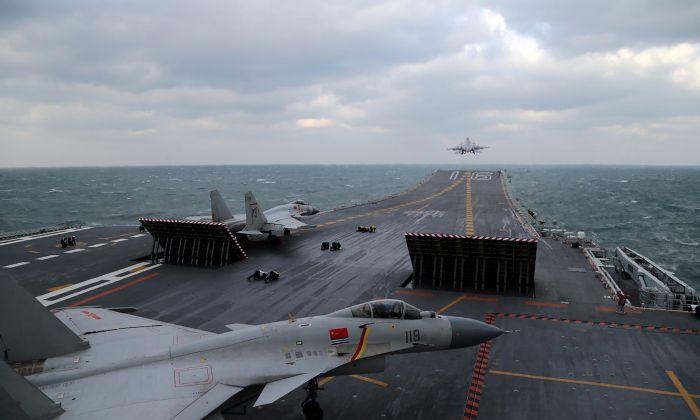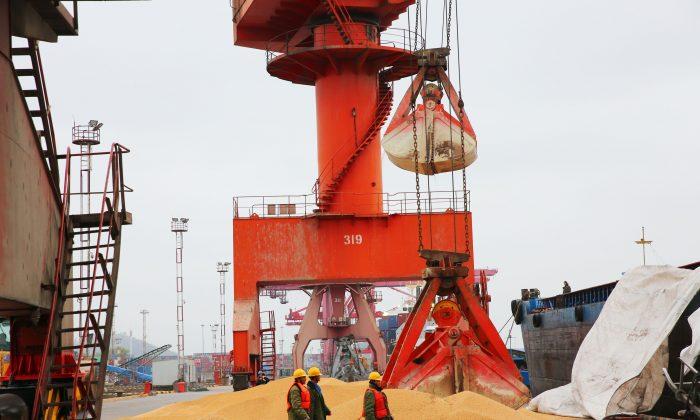News Analysis
China is slowing its plan to build a six-carrier fleet by putting construction of two aircraft carriers on hold due to technical challenges and high costs.
The National Interest
reported on Dec. 9 that military insiders revealed that plans for a fifth carrier have been stalled.
The Hong Kong-based South China Morning Post
reported that military insiders told the paper that “technical challenges and high costs had put the brakes on the program.” The move would effectively scuttle the People’s Liberation Army Navy (PLAN) strategy of using redundancy for its northern, eastern and southern fleets to push back the American Carrier Strike Groups that now freely transit the Pacific.
The six-carrier Chinese deployment strategy was seen as a direct confrontation with the U.S. Navy’s 11 deployable nuclear-powered carriers, plus 9 helicopter assault ships that can launch state-of-arts F-35 configured Naval deck take-off and Marine jump jets.
During three decades of economic engagement with the United States, China’s GDP grew from $347 billion in 1989 to $12.2 trillion in 2018. But relatively unnoticed until recently, China’s military budget spiked from $19.3 billion to $250 billion during the same period. China’s military spending came in second place behind the $649 billion U.S. budget, and far above Saudi Arabia’s $67.6 billion budget, according to a
report by Defense News.
China moved from spending mostly on defense to dramatically focusing on offensive weapons when Chinese leader Xi Jinping announced in April 2016 that he had taken personal command of China’s armed forces, including the People’s Liberation Army (PLA). In addition to his role as chairman of the Central Military Commission that oversaw the army, Xi took direct control as head of the new Joint Operations Command Center, effectively making him the
sole PLA operational commander in time of war.
Xi moved to reform China’s military to what Geopolitical Futures described as along American lines, rather than a “World War II-type force, heavy on manpower but not evolving technologically.” The PLA mimicked the U.S. Goldwater-Nichols Act of 1986 that created geographical commands—such as Central Command and Pacific Command—with forces operating under a single regional commander, regardless of service.
The air, sea, and ground components of the PLA were organized into five new geographic commands with a single commander in control of the forces at war. The 5 commands report directly to the Joint Operations Command Center managed by Xi. As a result,
Xi now controls both the political and the operational military commands.
China bought a decrepit Ukrainian aircraft carrier for scrap in 1998, but then rebuilt and commissioned it into the PLAN as the Liaoning Type 001 in 2012. Construction of a slightly improved second copy of the Liaoning, named the Shandong, began in late 2016. Both carriers are conventional fuel-powered and use a ramp layout that limits launching of aircraft to a maximum launch weight of about 30 tons.
As a result, China’s J-15 carrier fighter cannot carry a full load of fuel and weapons for more than short sorties over modest distances. But China began building nuclear powered third and fourth carriers with powered catapults long distance attacks in 2018.
China military expert and TV commentator Song Zhongping
told Global Times on Dec. 2018 that China needs at least five aircraft carriers to execute its military strategy. Retired PLAN high ranking officer Wang Yunfei responded that Beijing would need a six-carrier fleet to cover all three naval zones and allow for regular periods of supply, maintenance and retrofit.
By early 2019, each of China’s three fleets possessed
offensive capabilities equipped with 20 to 30 major surface warships, at least a dozen submarines, and various amphibious ships. The Liaoning also went operational with the Northern Theater Navy.
According to the MIT Technology Review
, the Trump administration’s increases in U.S. defense budget to over $649 billion annually had negated much of China’s military spending spike: “The size of America’s lead in annual military spending obscures just how much this difference has accumulated over the decades.”
MIT added, “More than any other single technology, aircraft carriers enable the American military to project force almost anywhere in the world,” making it improbable that the Chinese can ever catch up.
Chriss Street is an expert in macroeconomics, technology, and national security. He has served as CEO of several companies and is an active writer with more than 1,500 publications. He also regularly provides strategy lectures to graduate students at top Southern California universities.





